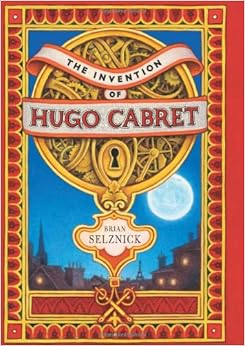The Invention of Hugo Cabret Book Review

Bibliography
Selznick, B. The invention of Hugo Cabret: A novel in words and pictures. Scholastic Inc., 2007.
Plot
Hugo Cabret is an orphan and thief who lives in a train station in Paris, France. He has been stealing parts from a toy shop, until one day when he is caught by the owner. This grumpy old man and his goddaughter steal a notebook from Hugo, with sketches of an automaton that Hugo was trying to rebuild. The automaton holds the key for Hugo to understand his father, but the old man and his goddaughter hold the key to finishing it. Hugo has to get the notebook back, finish the automaton, and see what the message is from his father. Along the way, he gains a family, the goddaughter starts to understand her godfather, and someone's imagination is reignited.
Critical Analysis
Selznick has written an interwoven story full of twists and turns, and unexpected surprises. Alternating between text and beautiful, pencil drawn pictures moves the story rapidly for the reader, and will keep readers engaged. The cohesiveness of the plot lines not only helps the story gain in attraction, but also creates that feeling of wanting to go back and read more for the details that are sure to turn up later in the story. Hugo, Isabelle, and Etienne are developed over a series of interactions which show their character and deepen them personally. Readers will even be rooting for the main character of conflict, Georges Méliès, by the end of the book. Selznick develops his characters with both good and bad evident, and makes the reader realize that all people have capacity for both. At the conclusion, the theme of family and forgiveness truly shines through a climax which accumulates all plot points in the past and present of the characters.
The illustrations of the book accurately capture the setting of 1930's Paris. Although portrayed in black and white, the illustrations serve the book in displaying the theme of dark and light through the shadowy double paged pictures and detailed close ups. Selznick uses the effect of zooming in on an object with each page turn frequently; this heightens anticipation and will leave readers wanting to know why and what is next. The book is beautifully distinguished as partial picture book, partial novel. This will appeal to a wide variety of age levels and may draw reluctant older readers to try deeper stories.
Personal Response
When I first picked up The Invention of Hugo Cabret in the library, I thought it might take me a few nights to read it. I was incorrect; the book kept me turning pages into the night to reach the end. The story captivated me with its interconnectedness of the characters in the past and as they interacted in the present. The emerging theme of family and healing through forgiveness struck a chord and caused me to keep reading on. Finally, the pictures were stunning in their detail and thoughtfulness. As noted above, the effect of each successive picture zooming in to a new detail of the picture before was delightful. The book has so many details, I felt I should read it again immediately after I'd finished it. For example, in the book there are frequent close ups on shoes, and it is referenced later that the old man has an awful past experience with shoes. The entire book is beautiful, and a type of book that I had not encountered before, being both novel and picture book. I highly recommend this to any reader.
Excerpts of Reviews
"The hand-off between the written sections of the novel and its illustrated portions always occurs at precisely the right moment, such as the introduction of a new character or at the beginning of a chase scene. Likewise, the text provides welcome opportunities for the reader to catch his breath by offering some distance from the action and allowing Selznick to take the storytelling reins once again." Christian Science Monitor
"A unique reading experience lies between the covers of Brian Selznick's ingenious The Invention of Hugo Cabret. "This is very different than a graphic novel," says the author. "It's more like a 550-page picture book." Kirkus Reviews
"With characteristic intelligence, exquisite images, and a breathtaking design, Selznick shatters conventions related to the art of bookmaking in this magical mystery set in 1930s Paris." School Library Journal
Connections
1.) Watch a film by Georges Méliès, or another French movie producer.
2.) Draw scenes from their own imagination, such as Georges Méliès did to create the movies.
3.) Research and find out more of what life was like in Paris, France, during the 1930's. Learn about the history of the time.
4.) Discover more about the concept of time, and read other stories which have time involved. Some of these stories may include: A Child's Calendar by John Updike, How Do You Know What Time It Is? by Robert E. Wells, or Just a Second: A Different Way to Look at Time by Steve Jenkins.
5.) Learn about other famous clocks around the world with books such as:
Clocks by Tony Barrs
The Grand Central Terminal Clock, New York, United States - Peter in Grand Central Station by Leonard W Shortall
Glockenspiel, Munich, Germany - Gordon and the Glockenspiel by Lee Ryland
Big Ben's Great Clock, London, England -Big Ben : a little known story by Mark Loyd
No comments:
Post a Comment